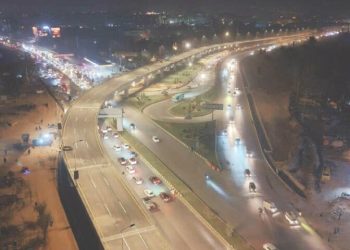- The number of Americans living in Japan has grown slightly from 2020 to 2022, from 57,214 to 60,804.
- Some Americans cite Japan’s cheaper healthcare and greater affordability as reasons for moving.
- Four recent relocators share why they chose to move to the island nation, and how it’s working out.
Veronica Hanson was ready to leave the US by any means necessary.
Hanson, 37, was living in Lake Oswego, Oregon, but made plans to flee the US once she believed the country became too dangerous for her and her children.
“My children had to do active shooter drills,” Hanson told Insider. “There were multiple times over a couple-year period where the air was unbreathable because of the wildfires. I just exploded and said we don’t have to stay here, let’s go.”
Hanson and her family are a few of the 6,642 Americans who moved to Japan in 2022, according to the country’s Ministry of Justice. The same source said the population of American expats in Japan grew slightly over the past few years, from 57,214 in 2020 to 60,804 in 2022.
More and more Americans are exploring their options outside of the US, seeking affordability and quality of life. While countries like Mexico and Canada are more popular go-to’s for American expats, Hanson — and three other recent movers Insider spoke with — said Japan is delivering on what she found to be lacking in the US.
An Oregon woman moved her family to Japan for peace of mind
Hanson and her family didn’t immediately decide on Japan when it was time to move — she just knew she wanted to get out of the US.
“I got a lot of flack for this when we left because people had this sentiment that I wasn’t doing it for a positive reason,” Hanson said. “I wasn’t doing it because I wanted to be somewhere specific. I just wanted to be anywhere else.”
Their first stop was the Dominican Republic in November 2020. Hanson’s mother is Japanese, and said she would join in leaving the US if she could find a way to live in Japan. Hanson, her husband, and their children, who are now 11 and 9, arrived in Japan in March 2022. Because Hanson’s grandparents are Japanese, she and her family are eligible for long-term resident visas.
Veronica Hanson
Hanson kept her 1,915-square-foot, three-bedroom house in Oregon, which she bought for $262,000 in 2013, but lists it on Airbnb to help cover her rent in Tokyo. For a 1,184-square-foot, three-bedroom home, she and her husband pay 600,000 yen, or about $4,321, a month.
She said a lot of the expenses in Tokyo, like groceries, are comparable to the US, but the safety — which was her number one priority — is priceless.
“One of my favorite parts about Japan is safety,” she said. “I am honestly so appreciative of the ability to be able to live in this safe community.”
A former pharmacist prefers the healthcare in Japan to the US
Alex Evans is also grateful for Japan’s safety.
Evans, 38, is an avid cyclist and said he doesn’t feel the need to lock his bike when entering a store.
Alex Evans
He was also worried about gun violence and how that would affect his 5-year-old son in the US.
“I was very concerned about gun violence, which is almost non-existent in Japan,” Evans told Insider.
Along with the safety of Japan, Evans was also pleasantly surprised by the affordability. Evans, alongside his wife and son, moved to rural Mukaishima Island, 62 miles from the southern city of Hiroshima, in June 2022.
For a three-bedroom house, Evans pays 65,000 yen per month. If he were in Hiroshima, Evans said, his rent would be more expensive.
Evans owns a medical writing business, and was a pharmacist in the US, so he’s well-informed on the ins and outs of the healthcare system. But it turns out that it’s much simpler in Japan.
“We have one insurance card and we go to the town hall and get it,” he said. “You basically just show that you’re a resident of that town and you get handed your insurance card.”
He recounted a minor surgery he had to remove a cyst on his face. He said all in all it took about 45 minutes and cost some 8,500 yen.
“The doctor wanted to see me for a follow up six days later to check on the stitches — it was 380 yen each time, which is like $2 for my copay,” Evans said. “I was on a pharmacist salary in the US, and you always feel like you’re just one car accident or major illness away from bankruptcy.”
An Aussie loves the culture and hospitality
Anne Sutherland-Smith was born in Australia but was living as an American citizen in Austin, Texas, with her family when wanderlust overtook her. In May of this year, she decided to start a new chapter in Kyoto.
“The decision to leave the US was not about escaping but about seeking,” Sutherland-Smith told Insider via email. “Japan had always fascinated me, with its seamless blend of the old and the new, its profound cultural nuances, and the kindness of its people. Other countries did pique my interest, but Japan, to me, felt like a calling.”
Anne Sutherland-Smith
Sutherland-Smith rents a 1,000-square-foot, two-bedroom traditional home for 200,000 yen per month — slightly less than the $2,500 she was paying for a three-bedroom house in Austin.
Sutherland-Smith finds some of the day-to-day expenses more costly than in the US. However, groceries and transportation cost more because the experience is better, she said.
“The quality of goods and services in Japan is exceptional,” she said. “Japan’s public transportation system, in particular, is efficient, clean, and punctual.”
She is also a fan of Japan’s commitment to tradition and the hospitality that comes with that.
“Living here has been a series of delightful surprises,” she said. “The warmth and hospitality of the Japanese people, their willingness to go out of their way to assist, has been incredibly heartwarming.”
She went soul searching in Japan after burnout hit in America
Bethany “Bitsii” Nakamura was looking for a culture reset from her grueling nine-to-five in the US.
Bethany “Bitsii” Nakamura
“It was several years leading up to this moment where I was burnt out on corporate priorities and a focus on financial gain and competition,” Nakamura told Insider.
Bethany Nakamura
Nakamura, 35, started the process of moving to Japan from her studio in Jersey City, New Jersey, in 2020. Because of the pandemic, she didn’t get to Japan until October 2021.
Nakamura lives in a rural seaside town on Shikoku Island, which is about 164 miles from Osaka. She lives in a formerly abandoned house that she acquired for free through word of mouth. There is, however, a government program selling vacant houses for cheap.
Nakamura was an interior designer in the US, but taught English when she first arrived in Japan. Having hit the reset button, she’s now focusing on her YouTube channel where she explores the Japanese countryside. She’s also doing freelance design work.
“I had read that to get back in touch with yourself, you can think about what you liked as a child. I was so curious about Japan, and I loved Ghibli movies,” she said, referring to the Japanese animation studio. “I was thinking about 10-year-old Bethany.”









